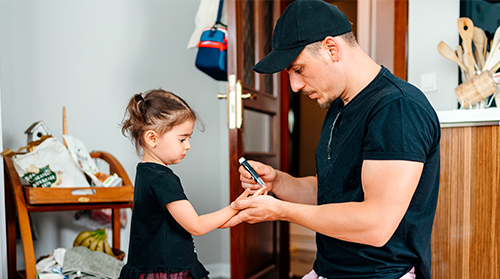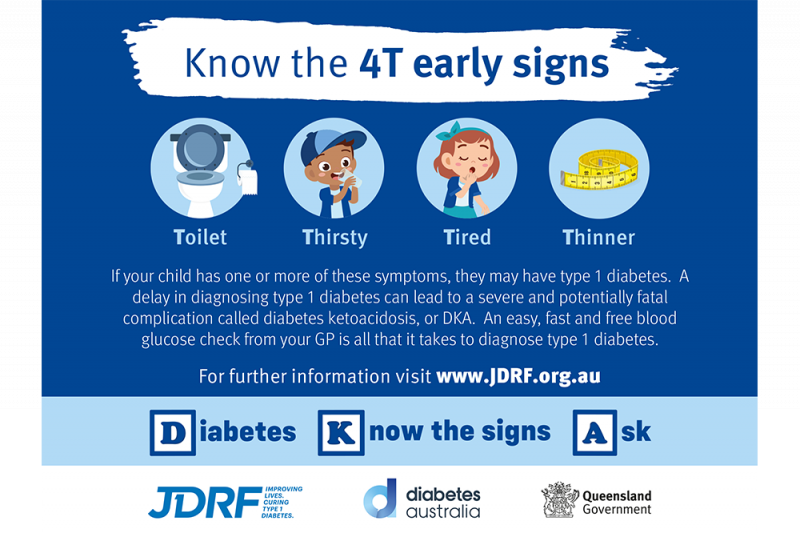
A kneeling father does a finger prick blood sugar test on his young daughter who has type 1 diabetes
The Queensland Children’s Hospital says children are presenting with diabetic ketoacidosis (DKA), a dangerous complication of undiagnosed type 1 diabetes, at alarming rates.
Type 1 diabetes is the most common form of diabetes affecting children and adolescents in Australia and one of the most common chronic childhood conditions.
It’s a life-threatening, life-long condition. Learn how to recognise the symptoms, and what to do.
What is diabetes?
Diabetes is complex condition where the body is unable to maintain healthy levels of glucose—a type of sugar—in the blood.
When we eat, our bodies break down the food, and we absorb the nutrients we need into the bloodstream.
These nutrients include glucose that our cells take in and use for energy. It is the main source of energy for the body.
When the glucose level in the blood rises after a meal, our pancreas makes the hormone insulin in response. It tells our cells to allow glucose in. Insulin is essential for the conversion of glucose into energy in the body.
What is type 1 diabetes?
In people with type 1 diabetes, the body doesn’t make enough, or any, insulin, so glucose can’t enter the cells.
Type 1 diabetes occurs when the person’s own immune system attacks the special cells in the pancreas that produce insulin.
It’s a life-threatening condition that represents around 10 per cent of all cases of diabetes and impacts those diagnosed for the rest of their lives.
What are the symptoms? Remember the 4T early signs
Your child may have diabetes if they show any of the 4T signs – toilet, thirsty, tired, thinner
Knowing the signs early could save your child’s life.
Let’s look at each in a little more detail:
- Toilet—going to the toilet a lot, bed wetting by a previously dry child or heavier nappies in babies
- Thirsty—being really thirsty and not being able to quench the thirst
- Tired—feeling more tired than usual or having no energy
- Thinner—losing weight or looking thinner than usual
If your child also has tummy pain, vomiting, sleepiness, and deep breathing this may indicate diabetic ketoacidosis (DKA) which is a serious complication of untreated diabetes.
You can remember DKA as follows: Diabetes | Know the signs | Ask
In DKA the body breaks down fat for energy because it is unable to use sugar. This produces ketones in the blood and high levels of ketones can cause the blood to become more acidic.
If you believe your child may have DKA, take them immediately to your nearest hospital for emergency assessment.

Who is at risk?
Anyone can get type 1 diabetes but you are at more risk if you have a first-degree relative with the condition. Testing is available through the Diabetes Service at the Queensland Children’s Hospital for siblings of children with type 1 diabetes to assess their risk for developing the condition in the future. There are also trials being done to assess whether certain drugs can slow down the progression to developing type 1 diabetes in those at risk.
It is not lifestyle related, its exact cause is unknown at this time, and is not related to anything done (or not done) by parents or their children.
Once someone has type 1 diabetes, it requires lifelong management.
Why is type 1 diabetes often missed?
Type 1 diabetes can often be missed in children or babies by parents or carers by putting the signs down to:
- age
- hot weather
- a growth spurt
- importantly, disposable nappies can disguise how often a toddler is weeing.
Diagnosis
If you notice any of the 4T signs, don’t delay getting an easy, fast and free finger-prick blood glucose check at your local GP.
Your GP will be able to tell you immediately if your child has type 1 diabetes and will advise you about the next steps.
If your doctor believes your child has type 1 diabetes, they will be immediately referred to the nearest emergency department for assessment.
A delay in diagnosis can lead to DKA which can develop rapidly and cause death if not treated. DKA often requires immediate admission to paediatric intensive care for treatment.

Living with type 1 diabetes
With the right care and support, a child with type 1 diabetes can lead a healthy and happy life.
Type 1 diabetes needs careful daily management to ensure glucose levels remain stable and within a healthy range. This involves a careful balance between food intake, exercise and medication.
Type 1 diabetes is treated by replacing the body’s missing insulin and people with this condition must:
- use insulin every day (usually four to five injections per day or an insulin pump)
- regularly test their blood glucose (up to six times per day) or use a glucose sensor
- eat a healthy diet matched with the insulin dose
- take exercise as any other child of the same age.
Education to enable self-management is the cornerstone of diabetes care and continues at all ages and for the duration of the illness.
Diabetes Queensland has a wealth of information for children and teens who have recently been diagnosed with, or are living with diabetes, including information about school action and management plans for students with diabetes, exams, sport days and school camps, as well as resources for schools, parents and carers.
Having a child diagnosed with type 1 diabetes can be scary and upsetting for parents and carers. Diabuddies is a supportive community for parents and carers of children living with type 1 diabetes, where you can connect, ask questions, and feel supported.